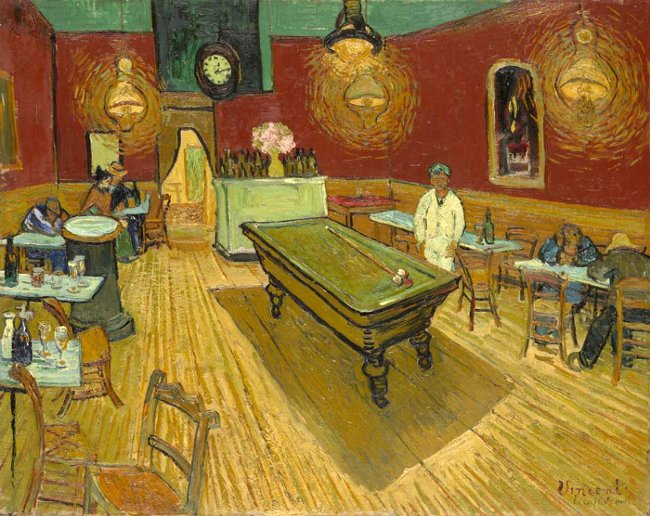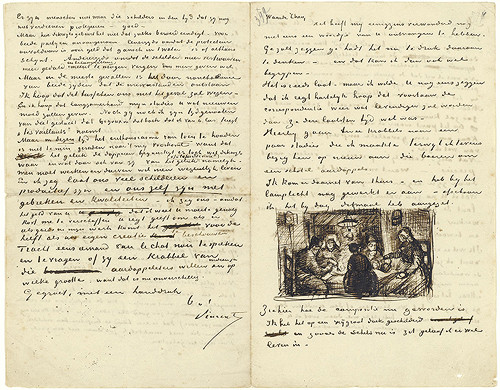New hypothesis about the mysterious death of Van Gogh's artist
In the 70s and 80s of the nineteenth century, Vincent Van Gogh, the artist, lived on the verge of extreme poverty along with severe depression. And in the mountain of letters left, Van Gogh occasionally wrote about the gas-lit lamp he used to work in the dark night.
He did not like the candle lamp because the light was so dim that at that time the electric light was not as widespread as it is today. However, light gas is produced from coal and contains a lot of impurities, heavy metals and carbon monoxide so it is extremely toxic to human health.

The painting "Café de Nuit" by Van Gogh, September 1888.
Some of Van Gogh's famous works, such as "Café de Nuit" , were completed under gas light . At the height of his talent (often coinciding with the period of heavy depression), Van Gogh thought of installing a gas pipeline to the house he rented in Arles, southern France, in 1888. From here , some new hypotheses regarding the suicide of Van Gogh began to appear.

Van Gogh's letter to his brother According to Van Gogh, April 9, 1885.
In early 2015, Dutch chemical engineer Rene van Slooten came up with some new theories after watching a documentary about Van Gogh on television. In the film, a Dutch artist mentions a painting of Van Gogh's house in Arles and notices that the road was smashed when the artist proceeded to install a gas pipeline. Van Slooten then thought of a new scenario that could explain Van Gogh's illness and even lead to a decision to end his life at the age of 34.
As a chemical engineer, Van Slooten understands the use of gas as well as preventing its toxins in the industry. Slooten explains: "When gas lamps are lit, toxins and metals such as carbon monoxide, lead and arsenic arise. We know that they are the culprits causing many diseases such as shock, hot temper, depression, mental disorders and suicidal tendencies ".

The article about Van Gogh's death in L'Echo Pontoisien, August 7, 1890.
Van Gogh started to show severe mental illness for the first time in Arles in 1888 , ie the period when the artist installed a gas pipeline into a rented house. His condition worsened due to the habit of drinking bitter wormwood and cognac. In the letter Van Gogh sent to his brother Theo van Gogh: "If the storm in the heart is too intense, you will drink a lot of shock."
According to a study published in the American Journal of Psychiatry of the United States in 2002, Van Gogh's mental health has become more and more erratic: "The creative activity is alternating with the listless state of exhaustion to exhaustion. "Uncertainty is difficult to predict, alternating with an ambiguous state of excitement or agony that becomes more and more frequent." The letters that Van Gogh wrote from Arles later found a sense of sanity but appeared panicked when referring to what was going on in his head.

Van Gogh's "Autobiography" (1889), with a bandaged ear.
The picture written in a letter: "I cannot describe exactly what is happening to me. Now and later there are worries of unknown cause, or feeling empty and tired in my head. At that time, my heart felt heavy and sad and regretful. In December 1888, after an intense argument with Gauguin and when he heard the voices in his ears, Van Gogh decided to cut off his left ear and send it to the most beloved prostitute. His to preserve households. According to Van Slooten, during his medical treatment at Saint Remy Hospital, Van Gogh continued to poison carbon monoxde from gas and paraffin lamps . In 1890, Van Gogh went to Auvers-sur-Oise and committed suicide on a wheat field, in despair.

Van Gogh's bed at St. HospitalPaul de Mausole in St.Remy (France).
Van Slooten argues that the consequences of Van Gogh's gas poisoning are similar to the case of American horror poet and writer Edgar Allen Poe and his wife Virginia in the previous few decades. . Poe died in 1849, and Virginia died of tuberculosis two years earlier. The research report later revealed: "The uranium level in Virginia's hair when she lived in New York City using gas lamps was very high, similar to the level found in miners of uranium mining and approximately high. more than 15 times the current normal level ".
Van Slooten published his theories about Van Gogh and Edgar Poe in the Baltimore Post-Examiner. However, Van Slooten's hypothesis about Van Gogh did not convince people. For example, Piet Voskuil - neuroscientist and Van Gogh expert - commented that the hypothesis is completely unreliable: "Van Slooten draws conclusions based on assumptions. What Van Slooten does is to collect There is no science, where are the other patients? Why are his roommates - Paul Gauguin among them - not suffering from similar symptoms? self? ".
Voskuil said there is no evidence of an increase in arles-related mental patients at that time. Voskuil said: "There are too many other ways to explain Van Gogh's symptoms".

Van Gogh's descendants take care of the grave of the artist in Auvers-sur-Oise (northern France) on July 29, 2015.
However, the possibility of carbon monoxide poisoning cannot be ruled out and may even be a factor that exacerbates the illness. Today, carbon monoxide continues to be a silent killer. In the Netherlands alone, between 10 and 20 people die each year and about 80 people are hospitalized due to gas poisoning , even though it is cleaner than natural gas. Van Slooten also believes that carbon monoxide poisoning causes psychological effects such as depression and mental disorders, nightmares and anxiety; while doctors refer to other causes of such problems.
- Test hypothesis 'Matrix'
- The mysterious death of Bruce Lee has been predicted?
- Artist painter
- The mysterious death of a burned person in a closed room
- The mysterious death pit swallowed 25 tons of fish in a split second
- Mysterious giant skulls in the Death Valley
- The 550-million-year-old mysterious creature reveals strange evolution on Earth
- New hypothesis about the apocalypse in September
- The top American doctor believes in
- New hypothesis about fish people
- Mysterious death of 7 talented scientists in the world
- Mysterious stone moves itself on Death Valley
 'Fine laughs' - Scary and painful torture in ancient times
'Fine laughs' - Scary and painful torture in ancient times The sequence of numbers 142857 of the Egyptian pyramids is known as the strangest number in the world - Why?
The sequence of numbers 142857 of the Egyptian pyramids is known as the strangest number in the world - Why? History of the iron
History of the iron What is alum?
What is alum? Red hot lava flowing on snow causes confusion
Red hot lava flowing on snow causes confusion  He was awarded the title of professor at the age of 30, the youngest director in the history of Vietnamese science!
He was awarded the title of professor at the age of 30, the youngest director in the history of Vietnamese science!  Van Gogh's paintings contain surprisingly accurate physics knowledge.
Van Gogh's paintings contain surprisingly accurate physics knowledge.  Waterspout swept away ships and boats in Khanh Hoa sea
Waterspout swept away ships and boats in Khanh Hoa sea  Unexpectedly discovered Van Gogh's portrait hidden behind the painting for more than 100 years
Unexpectedly discovered Van Gogh's portrait hidden behind the painting for more than 100 years  Dolphins 'dance' in front of a fisherman's boat in Khanh Hoa waters
Dolphins 'dance' in front of a fisherman's boat in Khanh Hoa waters 